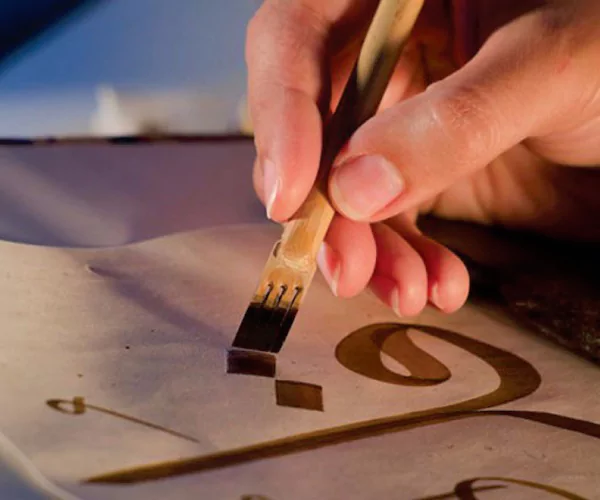
The harmonious fusion of form, accuracy, and artistic expression found in calligraphy is what makes it so beautiful. Each skillfully placed stroke conveys a narrative and creates a visual dance that captures the spirit of the written word. The rhythmic flow and precise nuances of calligraphy are mesmerizing, whether it be the beautiful bends of Arabic calligraphy or the refined simplicity of Japanese shodo. Everything is beautifully reflected in the different types of calligraphy that exist throughout the world.
It is an example of how well human imagination can elevate ordinary letters into a captivating visual tapestry. Calligraphy enables us to recognize the deft balancing act of nothingness and ink with each stroke, resulting in a timeless appeal that surpasses language and country and captivates hearts and minds for eons.
The basic purpose of calligraphy is to entice and make sure the one who intends to buy it feels a certain beauty and is struck by its craft, it's much more important to feel that influence than owning a piece of art for the sake of having it. Purpose can be found in different ways starting from something that can be simple to something that feels much grand.
Expression of the artist:
Calligraphy is frequently thought of as an aesthetic medium. To produce written compositions that are aesthetically pleasant and visually appealing, artists employ a variety of writing tools and techniques. A compelling type of visual art, calligraphy enables artists to mix the elegance of written language with creative expression.
Cultural identity:
Cultural legacy is greatly preserved and represented via calligraphy. Numerous calligraphic customs have their roots in past events and customs of particular nations. They serve to reflect a culture's language, principles, and aesthetic traditions in a visual way. A community's or country's identity can be celebrated and preserved through calligraphy.
Communication:
Calligraphy used to be essential for preserving and transferring information. Calligraphers were in charge of manually copying and transcribing significant papers, manuscripts, and books before the printing press was created. These documents may be comprehended by others thanks to expert calligraphy work.
Spiritual bend:
In several civilizations, calligraphy frequently has a spiritual and religious significance. It is employed to write religious lyrics, prayers, and sacred writings. The meticulous and contemplative technique of lettering can be a manifestation of adoration and respect for the divine.
Mindfulness:
A thoughtful and meditative aspect can be seen in calligraphy. The careful, focused movements needed to create calligraphy can help to relax the mind. Since calligraphy necessitates complete focus and attention on each stroke, many calligraphers view their hobby as a sort of mindfulness.
decoratives:
Numerous decorative uses for calligraphy exist, including ornaments inscriptions, and signage. It gives diverse things, such as artwork, architecture, pottery, and personal belongings, a touch of class, refinement, and artistic flair.
Different types of calligraphy reflect different types of flair and a specific style that the intent to reflect which can be found all around and more importantly each type brings a magic of its own, without straying away from being an art.
There are different types of calligraphy traditions all around the world, each has its own unique style and wisdom and also equally appeals to all senses. The very basic aspect is that the script-based specialty is mostly utilized focusing on the stroke and curve of each letter to add definition and an artistic bend.
Western calligraphy includes numerous types of calligraphy, including Latin, Gothic style, Italic, and Copperplate. While Gothic calligraphy uses sharp and angular characters, Roman calligraphy is distinguished by its straight and solid letterforms. Copperplate calligraphy is graceful and delicate, whereas Italic calligraphy is distinguished by its flowing and slanted characters.
Some of the earliest and most prestigious types of calligraphy are Chinese calligraphy. It covers a number of scripts, including cursive, regular, running, and clerical scripts as well as seal scripts. Each script has unique qualities and levels of intricacy of its own.
Chinese calligraphy has had a significant influence on Japanese calligraphy, also known as shodo. Japanese calligraphy is most frequently written in the block style Kaisho, semi-cursive style Gyosho, and cursive style Sosho. Each artistic expression and brushstroke is distinctive to that particular style.
Arabic calligraphy: In Islamic culture, calligraphy in Arabic is a fundamental type of visual art. It is renowned for its ornate and detailed lettering. Naskh, Thuluth, Diwani, and Kufic are the four main types of Arabic calligraphy. Every style has unique characteristics and is frequently applied to various contexts.
Indian calligraphy: There are many different regional scripts and calligraphic styles used in Indian calligraphy. Devanagari (used for Hindi, Sanskrit, and Marathi), Bengali, Gujarati, Tamil, and Telugu are a few well-known Indian calligraphy styles. Each script has its own cast of characters and means of expression.
Seoye or Hangeul lettering, a type of Korean calligraphy, has its roots in conventional Chinese calligraphy. It also has distinguishing qualities, though. Kaisho (regular script), Gyosho (semi-cursive script), and Hyeonmo (cursive script) are the three calligraphy types most frequently used in Korea.
The prime takeaway should be that each style has its own unique symbolism in it. Each focuses on the craft and its principles. Each time a letter is drawn, there is a unique set of hope and intention put forth by the artist.
Hence each type of calligraphy has a definitive intention for it and it mostly focuses on becoming something merely beyond just an art.